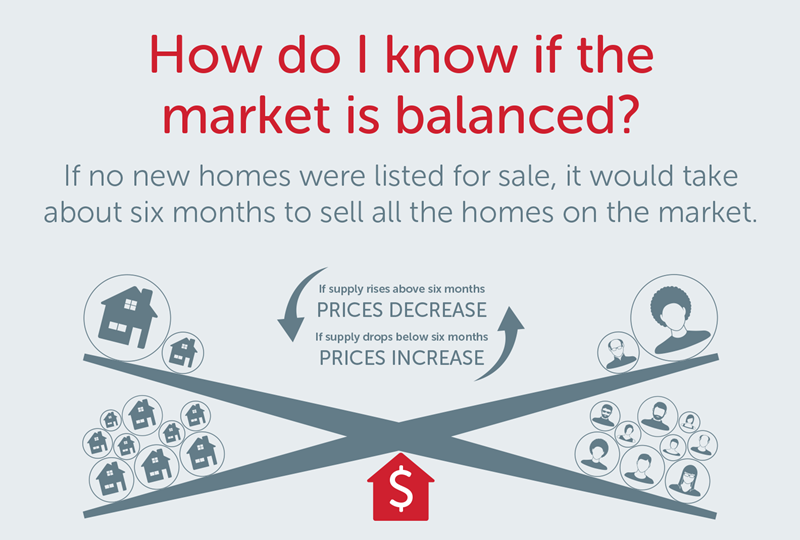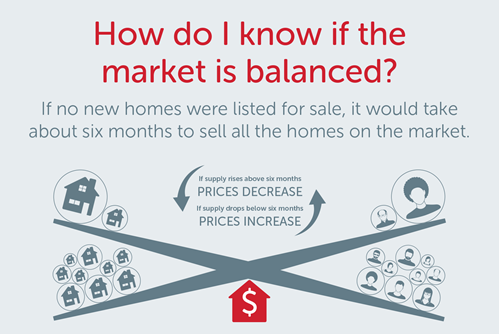
Whether you listen to the nightly news or pay attention to workplace water cooler discussions about the housing market, you’ve likely heard the terms “sellers’ market” and “buyers’ market” before.
We use these terms to describe who has an advantage in the housing market, but we don’t often discuss the factors that create these economic realities.
Here is a quick primer and infographic that will help you better understand how the market can swing from a buyers’ market, to a balanced market, to a sellers’ market — and how that could affect you if you’re buying or selling a home.
Key insights:
- In a balanced housing market, buyer demand matches the number of homes for sale.
- In a sellers’ market, there are more buyers in the market than there are for-sale homes — so the market favors sellers.
- In a buyers’ market, there are more homes for sale on the market than there are eager buyers — so the market favors buyers.
What is a balanced market?
Before we talk about a market that favors sellers or buyers, let’s head back to Econ 101 to discuss how a balanced market is created.
Remember learning about supply and demand? In the case of a balanced market, buyer demand matches the supply of for-sale homes in the marketplace.
In a balanced market:
- Buyers tend to place reasonable offers on homes and sellers tend to accept them.
- Homes remain on the market for a moderate amount of time — neither lagging for months nor getting snapped up in mere hours or days.
- Home prices remain stable, or grow at a steady pace.
Sounds pretty nice, doesn’t it? Well, economists would agree with you. While the housing market, like any market, tends to swing between favoring sellers and buyers, a market that reaches equilibrium can be the basis for long-term, steady growth.
What is months of supply? Why does it matter?
Of course, the market is often tipped in one direction or the other. To show how we determine that tipping point, we need to talk about a term called months of supply (also called the “absorption rate”).
Months of supply is a measurement that determines how long it would take for all existing homes on the market to sell, assuming:
- No new homes came on the market
- Homes continue to sell at the same rate as they have for the last 12 months, on average
In other words, if no new homes were listed for sale and the market clipped along at its current pace, how long would it take for all currently-for-sale homes to be sold?
In a healthy, balanced market, it would take about six months for the supply to dwindle to zero.
Now let’s talk about how a low supply can lead to a sellers’ market.
When does the market become a sellers’ market?
In terms of months of supply, the market tips to favor sellers when the supply drops to below six months of inventory.
This makes sense because in a low-inventory market, buyers may:
- Compete over homes
- Bid high or enter a bidding war to win their dream home
- Move quickly, because they know the competition is fierce
And of course, a fast-moving market with fast-rising prices is most definitely a market that benefits sellers.
When does the market become a buyers’ market?
Of course, the market can also shift the other way, if the months of supply rises above six months. In this case, high inventory would benefit buyers, and sellers would be at a disadvantage.
Why? Because when inventory is high, buyers can:
- Move carefully, and slowly, knowing that homes are unlikely to sell quickly (or that another similar home could be available soon)
- Enter in lower bids, especially on homes that have been on the market for a long time
- Avoid bidding wars, because there are more than enough for-sale houses to go around
When buyers can take their time and find a low-or fairly-priced home, the market advantage is aimed squarely at the buyers.
Here’s a quick visual recap:

Not an economist? Don’t want to be?
Don’t worry. While some folks love to follow the pendulum of the housing market, others prefer to steer clear of it altogether. Whether you’re ready to buy or sell, or you need guidance on how to time your move just right, our team of real estate professionals can help you navigate the ever-changing market.
Reach out to Edina Realty or your REALTOR® to get started.









 Equal Housing Lender | Prosperity Home Mortgage, LLC may operate as Prosperity Home Mortgage, LLC dba Edina Realty Mortgage in Minnesota and Wisconsin. ©2024 Prosperity Home Mortgage, LLC dba Edina Realty Mortgage. (877) 275-1762. 3060 Williams Drive, Suite 600, Fairfax, VA 22031. All first mortgage products are provided by Prosperity Home Mortgage, LLC. Not all mortgage products may be available in all areas. Not all borrowers will qualify. NMLS ID #75164 (For licensing information go to: NMLS Consumer Access at http://www.nmlsconsumeraccess.org/) Licensed by the Department of Financial Protection and Innovation under the California Residential Mortgage Lending Act. Licensed by the Delaware State Bank Commissioner. Georgia Residential Mortgage Licensee. Massachusetts Mortgage Lender and Mortgage Broker MC75164. Licensed by the NJ Department of Banking and Insurance. Licensed Mortgage Banker-NYS Department of Financial Services. Rhode Island Licensed Lender. Rhode Island Licensed Loan Broker. Rhode Island Licensed Third-Party Loan Servicer. Also licensed in AK, AL, AR, AZ, CO, CT, DC, FL, ID, IL, IN, KS, KY, LA, MD, ME, MI, MN, MO, MS, MT, NC, ND, NE, NH, NM, NV, OH, OK, OR, PA, SC, SD, TN, TX, UT, VA, VT, WA, WI, WV and WY.
Equal Housing Lender | Prosperity Home Mortgage, LLC may operate as Prosperity Home Mortgage, LLC dba Edina Realty Mortgage in Minnesota and Wisconsin. ©2024 Prosperity Home Mortgage, LLC dba Edina Realty Mortgage. (877) 275-1762. 3060 Williams Drive, Suite 600, Fairfax, VA 22031. All first mortgage products are provided by Prosperity Home Mortgage, LLC. Not all mortgage products may be available in all areas. Not all borrowers will qualify. NMLS ID #75164 (For licensing information go to: NMLS Consumer Access at http://www.nmlsconsumeraccess.org/) Licensed by the Department of Financial Protection and Innovation under the California Residential Mortgage Lending Act. Licensed by the Delaware State Bank Commissioner. Georgia Residential Mortgage Licensee. Massachusetts Mortgage Lender and Mortgage Broker MC75164. Licensed by the NJ Department of Banking and Insurance. Licensed Mortgage Banker-NYS Department of Financial Services. Rhode Island Licensed Lender. Rhode Island Licensed Loan Broker. Rhode Island Licensed Third-Party Loan Servicer. Also licensed in AK, AL, AR, AZ, CO, CT, DC, FL, ID, IL, IN, KS, KY, LA, MD, ME, MI, MN, MO, MS, MT, NC, ND, NE, NH, NM, NV, OH, OK, OR, PA, SC, SD, TN, TX, UT, VA, VT, WA, WI, WV and WY.